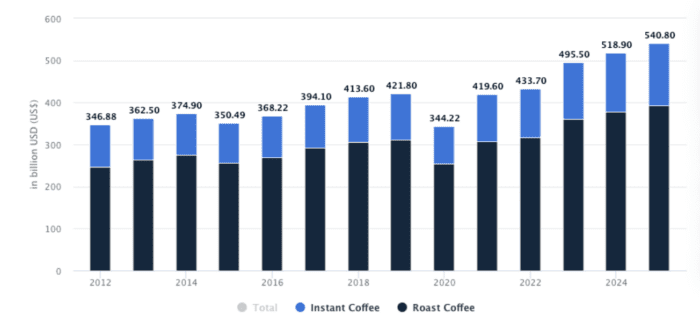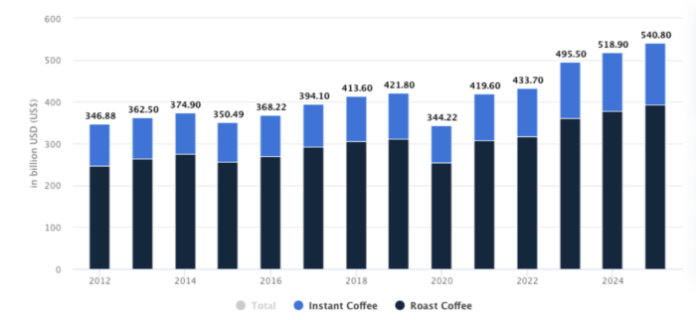As the coffee industry evolves, more and more consumers are turning to online shopping for their favorite brews.
Shopping online provides a convenient alternative to visiting physical stores as it allows you to browse a wider variety of blends, roasts, or decaf options all from the comfort of your home.
And with delivery times steadily improving over the years, many US consumers receive their online orders in just two to three business days. This makes online shopping a convenient way for people to always have coffee on hand.
This shift in buying habits has opened a whole world of possibilities for both established coffee retailers and those just looking to get their feet wet.
But if you’re interested in selling coffee online then you probably have a few questions about shipping orders. Things like:
- How much will shipping cost?
- What sort of fulfillment options are available?
- How can I ensure my packages don’t arrive damaged?
- Will the coffee stay fresh in transit?
In this guide, we’ll explore the latest ecommerce coffee trends, the challenges that come with shipping coffee, and how to ensure your coffee products can be shipped quickly and safely.
The coffee industry as a whole has experienced significant growth recently and that trend is expected to continue. According to Statista, the coffee market is expected to grow annually by 4.47% in the coming years.

Sales in the ecommerce space specifically have seen a significant boost in recent years, partly due to the COVID-19 pandemic.
According to Tea & Coffee and a webinar published by the National Coffee Association in 2020, Amazon saw a compounded annual growth rate (CAGR) of 36.9% in coffee sales. Searches for ground coffee peaked in March 2020 but are still higher than pre-COVID levels.
This change in the global landscape provided coffee lovers the opportunity to make purchases online whereas they may not have done so in the past.
But an increase in coffee sales worldwide only paints a broad picture of the industry. One of the most recent trends for businesses to capitalize on is offering coffee subscriptions.
Coffee subscriptions
Coffee subscriptions are a rapidly growing subsegment of the online coffee market and offer a convenient way for consumers to receive their favorite coffees on a regular basis.
The Specialty Coffee Association found that coffee subscription services had a 109% increase since 2019. These services allow coffee shipping businesses to better forecast how much inventory is needed all the while, increasing the lifetime value of their customer.
Running an ecommerce store versus a brick-and-mortar coffee shop presents two very different sets of challenges. You won’t be serving up an espresso or cold brew to your customers in person, but you’ll be tasked with delivering quality coffee to their doorstep on time.
Being aware of these challenges before embarking on your ecommerce journey can help you save both time and money.
Let’s dive into a few.
Shipping costs
One of the primary concerns when selling coffee online is the shipping cost. Shipping rates can differ based on a variety of factors, such as customer location, package weight, and more.
In order to remain competitive, it’s crucial for coffee companies to find cost-effective shipping solutions that can handle both domestic and international orders.
For example, non-dairy creamer and coffee company, Prymal, did just that when they made the switch from another 3PL provider to ShipBob. The switch saved them $8,000 per month on fulfillment costs and allowed them to hit $160,000 in monthly sales.
“Last July, Prymal reached $40,000 in revenue. After switching to ShipBob just four months later in November, we are reaching $160,000 a month in revenue — that’s 300% growth. We’re also saving $8,000 per month in fulfillment costs.”
Courtney Lee, Founder of Prymal
Freshness
As an ecommerce coffee brand, you’ll want to provide your customers with the best coffee possible. And you can’t have great coffee without it being fresh.
This means that coffee companies must prioritize efficient shipping methods that minimize the time between being roasted and delivery.
The use of proper packaging materials is also crucial for preserving freshness during transit. For example, some coffee brands may consider using boxes instead of bubble mailers to ensure the coffee makes it to the customer without being damaged in transit.
Shipping speeds
If there’s anything coffee fanatics love more than a great cup of coffee it’s getting their newly purchased bags of coffee — fast. Fast shipping is a key differentiator for many online retailers, and coffee is no exception.
In order to keep up with customer expectations, consider offering 2-day shipping.
One way to do this is by outsourcing order fulfillment to a 3PL that has multiple fulfillment centers. That way, you can distribute your inventory across facilities and shipping zones to achieve faster shipping. By reducing the mile radius an order has to travel, you speed up the transit time.
Environmental concerns
As the demand for online coffee shopping increases, so does the environmental impact of shipping. The use of packaging materials and the carbon footprint of transportation contributes to environmental concerns.
Eco-friendly packaging options are becoming increasingly important for both consumers and store owners alike. Although not something you need to prioritize directly out of the gate, it is something to keep in mind as you scale.
Additionally, by distributing your inventory across multiple fulfillment centers, you minimize the need for air transportation, which produces more carbon emissions than ground transportation.
Shipping costs for coffee products can vary depending on factors such as weight, packaging materials, carrier, and shipping destination.
Let’s go through an example of what Fedex, UPS, and USPS would charge to ship a 2-lb bag of coffee from New York to California.
We’ll assume that the box being shipped has the following dimensions: 14 x 6 x 4”.
| Carrier | Shipping Speed | Shipping Cost |
| Fedex Ground | 6 Days | $20.03 |
| Fedex 2Day | 3 Days | $71.84 |
| UPS Ground | 4 Days | $20.85 |
| UPS 3 Day Select | 3 Days | $50.35 |
| USPS Retail Ground | 7 Days | $15.00 |
| USPS Priority Mail | 3 Days | $17.05 |
With the same weight and dimensions in mind, now let’s take a look at the costs associated with shipping a 2-lb bag of coffee from New York to London.
| Carrier | Shipping Speed | Shipping Cost |
| FedEx International Economy | 7 Days | $192.49 |
| FedEx International Priority | 3 Days | $200.15 |
| UPS Worldwide Expedited | 4 Days | $186.74 |
| UPS Worldwide Saver | 3 Days | $202.25 |
| USPS First-Class Package International Service | Varies | $28.75 |
| USPS Priority Mail International | 6-10 Days | $69.10 |
Domestic shipping rates from New York to California are pretty similar across all three major carriers ranging from $15-21. Rates from New York to London are, unsurprisingly, significantly more expensive with USPS offering the most affordable options at $28.75 or $69.10.
Packaging coffee products properly is essential for elevating brand value, preserving product freshness, and minimizing damage during transit. Here are a few things to consider when choosing coffee packaging materials:
- Use customized packaging materials, such as branded boxes or labels, to create a memorable unboxing experience.
- Use airtight, resealable bags or containers to protect coffee beans and grounds from moisture and air.
- Use sturdy coffee shipping boxes or padded envelopes for shipping pods or capsules.
- Include proper dunnage, such as bubble wrap, to protect your coffee products during transit.
As you can see, there are a few things to consider when it comes to coffee shipping. Whether you’re sending coffee via domestic or international shipping, you want to be prepared for any issues that might come your way.
Below are three steps to follow before shipping your coffee out the door.
Step 1: Choose a carrier
Select a reliable shipping carrier that offers a balance of speed, cost, and reliability. Carriers, such as USPS, UPS, FedEx, and other regional carriers, offer a variety of shipping options and services to meet your needs.
Step 2: Buy shipping insurance
Shipping insurance can protect your coffee products against loss, damage, or theft during transit. Many carriers offer shipping insurance as an optional add-on to their services.
Evaluate the cost of insurance and the potential risks associated with shipping your products to determine whether insurance is necessary for your business.
Step 3: Research laws and fees
Before shipping coffee products, especially internationally, familiarize yourself with the import and regulations of the destination country.
Coffee is often harvested in countries such as Ethiopia, Colombia, and Peru. Some destination countries may have restrictions or require additional documentation for coffee shipments based on where the beans were harvested.
Additionally, consider any import duties or taxes that may apply to your shipments and factor these costs into your pricing. A fulfillment partner may be able to assist with the logistics of getting products to international customers. For example, ShipBob offers Delivered Duties Paid (DDP) shipping options to ensure customers receive their orders and have a positive international shipping experience.
ShipBob is a leading ecommerce fulfillment platform that can help you streamline your coffee shipping process. Whether you’re shipping coffee from your own warehouse or are looking for a reliable partner to fulfill your orders, ShipBob can help.
Some of the benefits of partnering with ShipBob include:
FDA-registered warehouses
ShipBob’s FDA-registered warehouses ensure that your coffee products are stored and handled in compliance with food safety regulations. So whether you plan on selling whole beans, grounds, or coffee pods, you can rest assured that ShipBob can fulfill your orders.
Network of fulfillment centers
With a network of over 30 fulfillment centers across the world, ShipBob can help you reduce shipping times and costs by strategically storing your coffee products closer to your customers.
ShipBob has fulfillment centers in the United States, Canada, UK, EU, and Australia, which allows you to fulfill orders in-country, bypassing hefty import fees and laws.
2-day shipping
ShipBob offers a fast 2-day shipping option in the US with 100% coverage across the continental US from even one fulfillment center, enabling you to meet customer expectations for speedy delivery and maintain the freshness of your coffee products.
Inventory management
ShipBob’s inventory management system helps you track and manage your coffee products in real-time. Keeping tabs on multiple SKUs and lot numbers can be time-consuming and overwhelming. A strong inventory management system takes care of this for you — reducing the risk of stockouts and ensuring efficient order fulfillment.
Full tech stack and integrations
ShipBob’s technology stack integrates seamlessly with popular ecommerce platforms like Shopify, WooCommerce, BigCommerce, and more. Additionally, ShipBob integrates with many of today’s most popular ecommerce platforms like Gorgias, Klayvio, Linnworks, and more.
By connecting your tech stack to ShipBob, you’re able to simplify the order management and fulfillment process and utilize ShipBob as a single source of truth for logistics.
If you’re interested in learning more about ShipBob and how we can help fulfill orders for your ecommerce coffee brand, connect with our team to get started.
Below are answers to the most common questions about shipping coffee.
Post Disclaimer
The information provided in our posts or blogs are for educational and informative purposes only. We do not guarantee the accuracy, completeness or suitability of the information. We do not provide financial or investment advice. Readers should always seek professional advice before making any financial or investment decisions based on the information provided in our content. We will not be held responsible for any losses, damages or consequences that may arise from relying on the information provided in our content.



